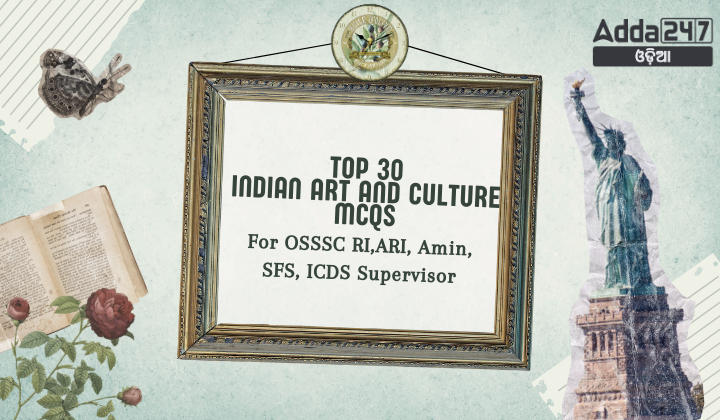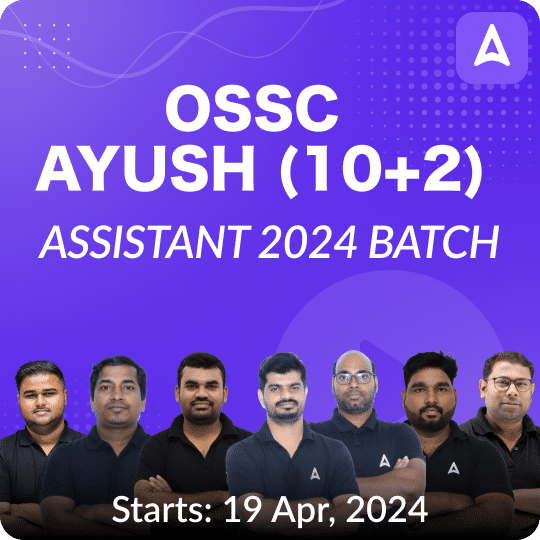The rich tapestry of Indian art and culture reflects the country’s diverse heritage, traditions, and history. For aspirants preparing for competitive exams like OSSSC RI, ARI, Amin, SFS, and ICDS Supervisor, having a comprehensive understanding of Indian art and culture is essential. To aid in your preparation, we’ve compiled a list of the top 30 multiple-choice questions (MCQs) covering various aspects of Indian art and culture.
Top 30 Indian Art and Culture MCQS For OSSSC RI,ARI, Amin, SFS, ICDS Supervisor
- How many classical dances are recognized by Sangeet Natak Akademi?
(a) 6 dances.
(b) 8 dances.
(c) 10 dances.
(d) 16 dances.
Answer: (b) 8 dances. - Kuchipudi is the classical dance of
(a) Odisha.
(b) Jharkhand.
(c) West Bengal.
(d) Andhra Pradesh.
Answer: (d) Andhra Pradesh. - ‘Pung’ is a percussion instrument. From which state is this?
(a) Assam.
(b) Chhattisgarh.
(c) Manipur.
(d) Mizoram.
Answer: (c) Manipur. - ‘Yakshagaana’ is a theatre from one of the south Indian states. Which state is referred to here?
(a) Kerala.
(b) Karnataka.
(c) Tamil Nadu.
(d) Andhra Pradesh.
Answer: (b) Karnataka. - Which of the following Indian paintings is also referred to as ‘Mithila Art’?
(a) Madhubani Painting.
(b) Pattachitra.
(c) Warli Folk Painting.
(d) Rajasthani Miniature Painting.
Answer: (a) Madhubani Painting.
Additional Questions: - Which of the following dance is not related to harvest?
(a) Bihu.
(b) Ponung.
(c) Parab.
(d) Popir.
Answer: (d) Popir. - ‘Ovi’ is a folk song of one of the Indian states. Which state is referred to here?
(a) Uttar Pradesh.
(b) Haryana.
(c) Madhya Pradesh.
(d) Maharashtra.
Answer: (d) Maharashtra. - The novel ‘Clear Light of Day’ (1980) is written by
(a) Anita Desai.
(b) Mulk Raj Anand.
(c) R.K. Narayan.
(d) Kamala Das.
Answer: (a) Anita Desai. - ‘Chandrakanta’ is considered to be the first work of prose in Hindi. Who wrote this?
(a) Jaishankar Prasad.
(b) Munshi Premchand.
(c) Devaki Nandan Khatri.
(d) R.K. Narayan.
Answer: (c) Devaki Nandan Khatri. - Which one of the following statements is correct?
(a) Amaravati Stupa lies in the gorge of the Cauvery river.
(b) Bhimbetaka cave shrines lie in the gorge of the Krishna river.
(c) Ajanta Caves lie in the gorge of the Waghora river.
(d) Sanchi Stupa lies in the gorge of the Chambal river.
Answer: (c) Ajanta Caves lie in the gorge of the Waghora river. - In India, the terms ‘Halbi, Ho, and Kui’ are associated with:
A) Tribal languages.
B) Award-winning play.
C) Musical instruments.
D) Dance forms of Northeast India.
Answer: A) Tribal languages. - “Whosoever praises his religious sector, or blames other sects out of excessive devotion to his own sect, with the view of glorifying his own sect, he rather injures his own sect very severely.” This advice was given by:
A) Chandragupta Maurya.
B) Harshavardhana.
C) Akbar.
D) Ashoka.
Answer: D) Ashoka. - Which of the following kingdoms had the notable feature of building ‘Kalyana Mandapas’ in temple construction?
A) Bahamani.
B) Cholas.
C) Vijayanagara.
D) Rashtrakuta.
Answer: C) Vijayanagara. - Swetambaras is a religious sect of:
A) Buddhism.
B) Jainism.
C) Shaivism.
D) Vaishnavism.
Answer: B) Jainism. - How many languages are recognized as “classical languages” in India so far?
A) 7 languages.
B) 3 languages.
C) 9 languages.
D) 6 languages.
Answer: D) 6 languages. - Nirvana in Buddhism is best explained by the statement:
A) A state of bliss and rest.
B) The elimination of the flame of desire.
C) A mental state beyond all comprehension.
D) The complete ignorance of self.
Answer: B) The elimination of the flame of desire. -
During which period did temple architecture in India begin and reach its climax?
A) Mauryan Period.
B) Cholas Period.
C) Gupta Period.
D) Mughal Period.
Answer: C) Gupta Period. - The temple of Koranganatha at Srinivasanallur is an example of:
A) Chola architecture.
B) Gupta architecture.
C) Pallava architecture.
D) Rashtrakutas architecture.
Answer: A) Chola architecture. - The highest point of Mughal architecture was achieved during the reign of:
A) Akbar.
B) Jahangir.
C) Shah Jahan.
D) Aurangazeb.
Answer: C) Shah Jahan. - Who is considered the founder of Rampur Sahaswan Gharana of Hindustani Music?
A) Ustad Alladiya Khan.
B) Ustad Inayat Khan.
C) Ustad Hassu Khan.
D) Ustad Nathu Khan.
Answer: B) Ustad Inayat Khan. - Which language has been recently included as one of the nine classical languages in India under the New Education Policy?
a) Farsi (Persian)
b) Arabic
c) French
d) Mandarin
Answer: a) Farsi (Persian) - What is the origin of Kathputli, a prominent puppet form in India?
a) Andhra Pradesh
b) Kerala
c) Rajasthan
d) Tamil Nadu
Answer: c) Rajasthan - Which puppet form involves the use of leather puppets casting shadows on a screen?
a) Kathputli
b) Gombeyatta
c) Tholu Bommalata
d) Pavakoothu
Answer: c) Tholu Bommalata - What is the characteristic feature of Gombeyatta puppetry?
a) String manipulation
b) Shadow casting
c) Dynamic movements with rods
d) Intricate detailing
Answer: c) Dynamic movements with rods - Which state is known for the puppet form called Pavakoothu?
a) Karnataka
b) Kerala
c) Himachal Pradesh
d) West Bengal
Answer: b) Kerala - What does the term “Sutradhar” symbolize in Indian classical theater?
a) Puppeteer
b) Narrator
c) Puppet form
d) Shadow puppetry
Answer: b) Narrator - Bommalattam puppetry originates from which Indian state?
a) Tamil Nadu
b) Rajasthan
c) Kerala
d) Andhra Pradesh
Answer: a) Tamil Nadu - Putul Nach, a puppet form, is native to which Indian state?
a) West Bengal
b) Tamil Nadu
c) Rajasthan
d) Kerala
Answer: a) West Bengal - What distinguishes Kondapalli Bommalu puppets?
a) Wooden puppets with intricate detailing
b) Lightweight wooden puppets with vibrant colors
c) Leather puppets casting shadows
d) Wooden glove puppets covered in cloth
Answer: b) Lightweight wooden puppets with vibrant colors - Which puppetry style combines elements of glove puppets and rod puppets?
a) Pavakoothu
b) Bommalattam
c) Koothu and Bommalattam
d) Gombeyatta
Answer: c) Koothu and Bommalattam
















